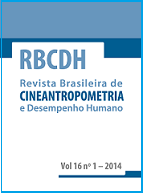Effects of ball recovery on top-level soccer attacking patterns of play
DOI:
https://doi.org/10.1590/1980-0037.2014v16n1p36Abstract
In soccer, ball recovery is the purpose of the defensive phase and it is also the first stage of the attack. Identifying how and where the ball is regained in elite competitions, taking in consideration the competition stage, is central to an understanding of the attacking patterns and of the diachronic order of events, and such knowledge can be used to develop specific drills in training. This study aims to characterize ball recovery patterns while taking into account the pitch zone(s) and the competition stage, and to investigate the influence of each type of ball recovery on the subsequent patterns of attacking play in matches played by the World Cup 2010 semi-finalists. Observational methodology and lag sequential analysis were applied, with the use of SoccerEye observational instrument, SoccerEye recording software and SDIS-GSEQ analytic software. Twenty-four matches were recorded from public TV broadcasts, yielding 1,619 attacks. Direct ball recovery was the most common form, with a tackle and defensive behaviour followed by a pass in the central mid-defensive zone resulting in goal attempts. Interceptions occurred mainly in the central mid-offensive zone inducing unsuccessful attacking patterns of play, while interventions by goalkeepers were most likely to occur in the central defensive zone with no significant associations with any ending of attack behaviours. Patterns of attacking play depend on the form of ball recovery. The pitch space and the form of ball recovery are similar when we compare both stages of the World Cup 2010.



